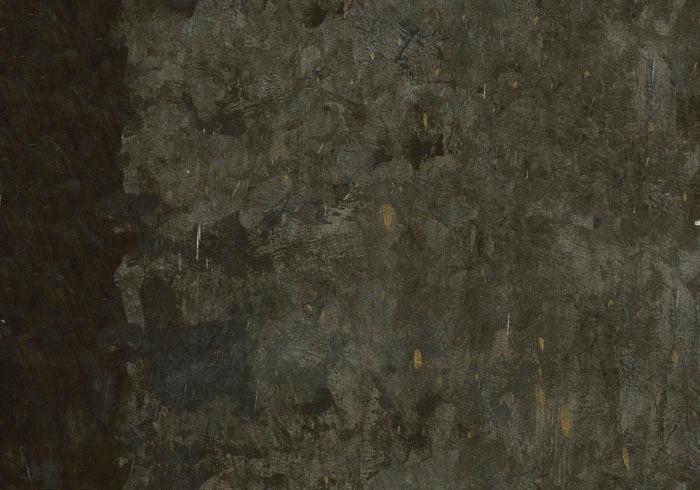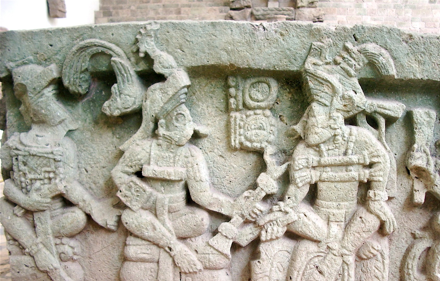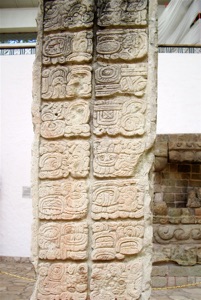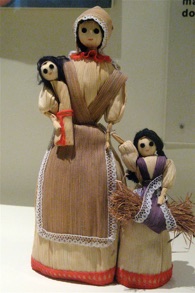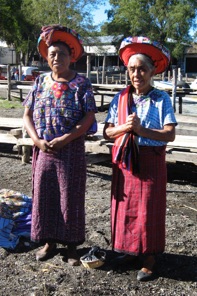Travel journal: January 16 - 29, 2008
There is no real route of the Mayas, but untold thousands of foot-weary tourists have already traveled sections of that geographical region, called Mesoamerica covering central and southern Mexico, Guatemala, Belize, western Honduras, and El Salvador. The Ancient Mayas used to live here. Behind them they have left imposing structures of a vibrant but long gone civilization, many of them just recently retrieved from the rapidly encroaching jungle. Their descendants still live in this region, but much of the knowledge of this ancient civilization, including the explanation of the glyphs on their structures, have just recently been unraveled by modern archeologists.
There are of course dozens of books, articles and blogs of travel in this region and here is another one. This one describes our trip we took and arranged by Overseas Adventure Travel. It is one of their most popular tours and in the high season they organize as many as 2-3 groups/week.
The tour started in San Salvador with a visit to the Joya de Cerén, then to Honduras to visit the famous ruins in Copan. We spent a few days in beautiful Antigua Guatemala, from where I took a day trip to the Pacaya crater. For the next stage we flew to Flores to visit the magnificent ruins of Tik’al. From there we swung by Yaxha and then drove to Belize and the ruins of Lamanai.
The Maya and Other Ancient Cultures in Mesoamerica.
Some archeologists used to believe that the Olmec culture (1250 - 600 BC), centered in Vera Cruz in Mexico, was the mother-culture of all subsequent societies, including the Maya culture. But now there is general agreement that the Olmec interacted with other cultural groups and because of this interaction, cultural traits spread out throughout Mesoamerica. The most salient traits of this culture are (a): a numerical system represented by bars and dots and which included the concept of zero, (b); calendrical systems and timekeeping based on detailed observations of the movement of the sun, moon, planets, and stars, (c) the use of ball courts for sport and for religious ceremonies, (d) the use of lime in the processing of maize, (e) the arrangement of buildings around a central patio or plaza, (f) the waging of war as a means to obtain political control, (g) the ritual importance of bloodletting, (h) belief in a range of gods, and (h), the importance of caves as routes to a watery supernatural underworld.
The prehispanic culture of the Mesoamericas was based on the presence of a multitude of deities. The principal ones were (1) Tezcatlipoca, god of the Starry Skies, represented by the Jaguar, (2) Tláloc, god of rain, and (3) Quetzalcóatl, the plumed serpent, strongly associated with the planet Venus. Some of the minor gods are Huehuetéotl, god of fire, usually depicted as an old man, Coaticue, goddess of the earth, and Chalchihutlique, goddess of the waters and wearing a skirt of jade.
The Maya culture and civilization are the most important subsets of the Mesoamerican culture. The first clearly “Mayan” settlement dates back to 1800 BC with sedentary communities and the use of pottery and clay figurines. But it is in the Classic period (250 - 900 AD) that the Mayan culture reached its apogee with large-scale construction, the recording of inscriptions on monuments, and significant intellectual and artistic developments. It is during this period when the Mayas developed numerous city-states, some of the most well-known of which are Tikal, Uxmal, Palenque, Tulum, Copán, and Calakmul.
Mayan history is typically divided into three periods. The Pre-Classic period lasted from 300 BC to 250 AD. The first Mayan settlements came into being, generally near the coast. During the Classic Period, from 250 AD to 900 AD, the Mayas moved inland, into the rain forest, and their art, architecture, religion and science developed tremendously. A major, and mysterious, disruption occurred about 900 AD. Experts have speculated that a combination of climatic change, epidemics, and a resultant peasant revolt to be the most logical reason. The cities were abandoned and there appears to have been a sudden loss in technical expertise and artistic excellence, signaling the start of the Post-Classic era, or period of decline. Most of the ancient cities were repopulated by 1000, and continued to have been inhabited until at least 1521, and some of the more remote cities even longer.
After 1521, the Spanish tried to systematically destroy Mayan civilization. In their religious fervor they burned the codices, which were written on ancient bark. Only four of these priceless books still exist today.
The Mayan Universe and Calendar
The Mayas believed the world was flat. The sky was a huge, multi-layered dome held aloft by giants, usually depicted in sculptures as old men. Under the earth is the underworld where people go after they die. The living rulers are known to be able to enter this world to converse with the dead. Access to this area is through caves and by boats with which to cross the vast underground lakes. There is equivalence here with the Greek boatman Charon ferrying the souls of the dead over the Styx.
Offering of blood to the gods is important. Captives were killed as offerings to the gods. But even the king himself offered his own blood by piercing himself in several places on his body, including his genitals. The queen would use a sharp rasp to bloody her tongue. The blood from the royal couple was collected in bark, and burned as offering to the gods. The kings would have been expected to have multiple consorts, but yet there seems to have been little strife in succession. Maybe this is because only the principal wife was allowed to have children, the others were made sterile by having them ingest plantain extract for 90 days.
The Mayan calendar uses three different dating systems in parallel, (1) the Long Count; (2) the Tzolkin (divine calendar); and (3) the Haab (civil calendar). Of these, only the Haab has a direct relationship to the length of the year. For dating purposes The Long Count is the most important; it uses 20 or 18 as base for each “digit”. The value of each digit is depicted on stelae and carvings as a combination of bars (for fives) and dots (for ones). So two parallel bars and four dots next to it would correspond to 14; one bar + 2 dots is equivalent to 7. The Mayans also understood the concept of zero, shown as a ellipse with a horizontal line and two short vertical lines inside the football-shaped form. So you have for the ‘digits’ the following:
1 k’in = one day. 1 winal = 20 k’in = 20 days. 1 tun = 18 winals = 30 days. 1 k’atun = 20 tun = about 20 years. 1 baktun = 20 ‘katun = about 394 years. So a date is depicted by, e.g., the 5 “digits” 9.5.12.2.17, which would correspond to 9 baktun, 5 katun, 12 tun, 2 winal and 17 k’in. Looking at the dates in use, correspondence with the Gregorian calendar was established when the Spanish invaded Mesoamerica. From this information we can calculate the origin of this calendar, when everything is zero, as corresponding to August in 3114 BC.
What is special with 3114 BC? Is this when the Mayans believe the world was created? Maybe it was when the stars and planets were in a certain alignment. We don’t know. Let us look at other ancient calendars. The Chinese have just celebrated their New Year, the year 4706. This means that their calendar started in 2698 BC, only 416 years later than when the Mayans started counting. Another ancient culture, the Assyrians of Babylon and Nineveh, are now in Year 6757, which would place their initial date at 4779 BC, much older than the Mayans or the Chinese. The ancient Egyptians started either in 2782 BC or in 4242 BC, the difference of 1460 years being the period when the heliacal rising of the bright star Sirius returns to the same point.
Interestingly, the Long Count Calendar will reset to zeros again on December 2012 AD, just a few years from now. What will happen then? Nostradamus very sensibly predicted, according to one interpretation, that (1) a Middle Eastern country will drop a nuclear bomb and (2) on this date the world will end. I believe this interpretation is too extreme. What will happen is that (1) the “bomb” Iran drops is that they will award the Knight Cross of the Imperial Order of the Odoriferous Camel Dung to an ex-president of a major country for how he handled his foreign policies and (2) Donald Trump was so peeved that he was not recognized he gave all his holdings away to the Calcutta Mothers of Infinite Charity, precipitating a major collapse of the stock market.
The second calendar system, called the Tzolkin, is based on weeks of either 13 or 20 days, and the cycle consists of 260 days. This was their “ritual” calendar. The “years” in the Tzolkin calendar are not counted.
The third system was called the Haab, which is the civil calendar of the Mayas. It consisted of 18 “months” of 20 days each, followed by 5 extra days. This 5-day period was considered “unlucky” and not much would be done in that period. Since the Tzolkin year was 260 days long and the Haab year was 365 days, every 52 years the starting dates of both systems would fall on the same day. The 52-year cycle is important, and many pyramids are rebuilt every 52 years to prevent the world from coming to en end.
The Mayan Hieroglyphs
Most of the written history of the Mayan civilization has been been destroyed, either through the overzealous efforts of the clergy who came with the Spanish Conquistadors to demolish as many of the heathen scriptures as possible or to the warm and humid weather which would rapidly rot artifacts made out of wood. So what is mostly left over are the glyphs carved in stone on stelae or on walls. Since much more effort had to be expended to create them, they generally only describe the doings of the upper class of the Mayas. The stelae on the right showing a collection of glyphs is in Copan.
The Mayans did not have the advantage of a Rosetta Stone, and the deciphering of these Mayan hieroglyphs has only recently been accomplished using a lot of deductions and detective work by modern scholars and archeologists, especially by the Mayanist Tatiana Proskouriakoff. She and others found that the glyphs represent a spoken language much the same as being used by contemporary Mayas.
In our alphabetic system, all words are based on combinations of only 26 characters. In the other extreme, the Chinese have thousands of characters, each of them having a special meaning. In the Mayan system we have some 800 signs. This number is too small to have a separate meaning associated with each character, but rather large for an alphabet. What happened is that the Mayas have a choice of many different signs to represent one sound. There are at least five different signs from which the Maya scribe can choose from the represent the Mayan syllable ba. Just like the use of combinations of different characters in the Roman alphabet to create a word, the Mayan approach is the same, except that they have a bigger choice of characters to choose from to describe a certain sound.

